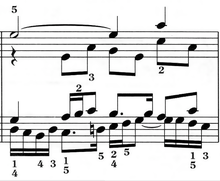
Back Kontrapunt Afrikaans Kontrapunkt ALS طباق (موسيقى) Arabic Contrapuntu AST Кантрапункт Byelorussian Кантрапункт BE-X-OLD Контрапункт Bulgarian Contrapunt Catalan کاونتەرپۆینت CKB Kontrapunkt Czech
In music, counterpoint is the relationship between two or more musical lines (or voices) which are harmonically interdependent yet independent in rhythm and melodic contour.[1] It has been most commonly identified in the European classical tradition, strongly developing during the Renaissance and in much of the common practice period, especially in the Baroque period. The term originates from the Latin punctus contra punctum meaning "point against point", i.e. "note against note".
In Western pedagogy, counterpoint is taught through a system of species (see below).
There are several different forms of counterpoint, including imitative counterpoint and free counterpoint. Imitative counterpoint involves the repetition of a main melodic idea across different vocal parts, with or without variation. Compositions written in free counterpoint often incorporate non-traditional harmonies and chords, chromaticism and dissonance.
- ^ Laitz, Steven G. (2008). The Complete Musician (2 ed.). New York: Oxford University Press, Inc. p. 96. ISBN 978-0-19-530108-3.
© MMXXIII Rich X Search. We shall prevail. All rights reserved. Rich X Search

